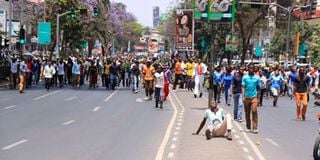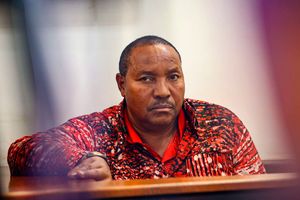Premium
An altered book on 2017 elections and why journalism is tomorrow’s history

Nasa supporters protest along Kenyatta Avenue on October 11, 2017 after the General Elections. It has been said that journalism is “the first rough draft of history”. Today’s news is tomorrow’s history.
For most readers, newspapers are disposable media. Today’s Nation will tomorrow become somebody’s meat wrapper, bhang roller, fire starter, shelf liner, window cleaner, car floor cover, shoes and bags shape keeper, shoe deodoriser, and so on. But not for Themina Kader.
Dr Kader, who has a doctorate in art education and cultural anthropology from The Pennsylvania State University, has just published an altered book using headlines, texts and images from newspapers, including the Nation, to retell for future generations the epoch-making story of the 2017 presidential election.
The unusual book, Kenya 2017: The Election That Was, is an eye-catching, impactful and creative portrayal of one of the most controversial presidential elections in Kenya. It allows the reader to visualise and envision the 2017 election. It gives the election a renewed look and meaning. Through collage, she re-portrays the election and subtly predicts the nature of future elections in Kenya.
Poetic licence
Kader has re-authored the election story by manipulating the arrangements of the newspaper headlines, text fragments, photos and images to create new meanings and themes. Using her poetic licence as the creator of an altered book, Kader has recast, re-ordered and replayed the media coverage of the election, which will likely continue to haunt us and shape the presidential election in August 2022 and beyond.
Altered books, otherwise known as artist’s books, are not common in Kenya. However, they’ve been popular in the publishing world since the 1960s. They’re often printed in limited editions. Kenya 2017 is available only through the author. Altered books are products of other books. Kader created hers from a Kenya Tourist Board brochure. Only snippets of the brochure remain.
She has altered the original publication’s appearance, subject matter and meaning. The new book deals with the “cultural divide between Kenyans of different ethnicities”.
Original publication
Kader says she created the book for posterity. “Young people in 20 years will vote for the first time. When and if they see this book, the questions they might ask are: Is this how we were in 2017? Have we matured enough by 2037 never to repeat 2017?”
She employs creatively the images and information from NMG publications — Daily Nation and The EastAfrican — and The Star newspaper. But the NMG coverage of the election dominates the book.
Kader rearranges the newspaper headlines thematically rather than chronologically to tell her story most effectively. Some examples of the headlines she has deployed: “It’s a pity politicians opted for mud instead of issues; don’t let them get away with it”, “Uhuru victory does not look good for long-term stability”, “Hidden players in Raila’s big U-turn”. Kenya 2017 utilises 17 political cartoons. All but one of them is by Nation cartoonist Michael Munene, known for his unambiguous messages. The first cartoon shows President Kenyatta driving a car along a road that is still being mended.
The speech bubble states: “The road to free, fair, credible and transparent elections is always under construction.” Ahead of the road, in the dark corner of the cartoon, we see IEBC’s Wafula Chebukati armed with a broad machete, attacking “Orders From Above”, “Rigging”, “Tribalism”, “Arm Twisting”, and “Corruption.”
Kader considers photographs vital for storytelling. She opens her book by quoting a Nation columnist saying “A picture speaks a thousand words — We’ve got a lot to say.” There are more than 10 action photos, some depicting riot police and political brutality.
Lessons
She states that the purpose of the book is to chronicle the history of the 2017 election and the lessons thereof. The accuracy of that history depends not only on the techniques Kader uses to put together the altered book but also on the journalism she relies on.
It has been said that journalism is “the first rough draft of history”. Today’s news is tomorrow’s history. That’s why it’s so important that what’s reported in the media today is accurate and truthful, for the media provides the raw data for historians.
The Public Editor is an independent news ombudsman who handles readers’ complaints on editorial matters including accuracy and journalistic standards. Email: [email protected]. Call or text 0721989264.





